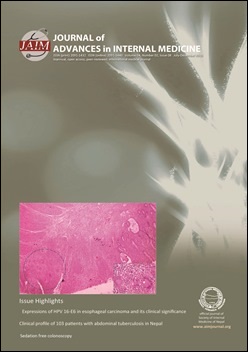Clinical profile of 103 patients with abdominal tuberculosis in Nepal
DOI:
https://doi.org/10.3126/jaim.v4i2.16896Keywords:
Abdominal tuberculosis, clinical profile, extrapulmonary tuberculosis, anti-tubercular treatment, therapeutic trialAbstract
Background and aims: The nonspecific clinical features of abdominal tuberculosis (TB) have made its diagnosis difficult, which can lead to the poor outcome in patients who are not able to receive early treatment. Hence, the aim of our study was to determine the clinical profile of abdominal TB in the patients of Nepal.
Methods: This is a prospective observational study in which 103 patients with abdominal TB were analyzed for clinical profiles from May 2010 to April 2015. All diagnosed patients received anti-tubercular treatment (ATT) and were followed up at 1 and 6 months of ATT.
Results: Among 103 patients of abdominal TB [males 48 (46.6%), females 55 (53.4%); mean age 33.1 years (±12.9)], 47.6% had histopathological examination (HPE) confirmation, 27.2% had high ascitic adenosine deaminase (ADA) value and another 25.2% had suggestive imaging findings. The common symptoms were abdominal pain (84.5%), weight loss (75.7%), anorexia (63.1%), chronic diarrhea (56.3%) and fever (52.4%). The mean weight was <50 Kg, hemoglobin <11 gm/dl and Erythrocyte Sedimentation Rate >40 mm/first hour. The sites involved were ileo-cecal (35.9%), peritoneal (27.2%), ileal (15.5%), colonic (15.5%), lymph nodal (3.9%) and gastroduodenal (1.9%). The sensitivity of HPE for diagnosis of abdominal TB was 47.6% (95% confidence interval 37.6% to 57.6%). All patients of abdominal TB had a good clinical response after ATT.
Conclusion: The common symptoms of abdominal TB were abdominal pain, weight loss, anorexia, chronic diarrhea and fever. Since the diagnosis of abdominal TB by HPE may not always be positive, other parameters such as ascitic ADA value, imaging findings and associated supportive clinical features have to be considered, and a therapeutic trial of ATT may be indicated so that all patients of abdominal TB can be treated early in the course of disease.
Downloads
Downloads
Published
How to Cite
Issue
Section
License
This license enables reusers to distribute, remix, adapt, and build upon the material in any medium or format, so long as attribution is given to the creator.




